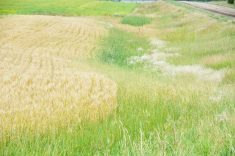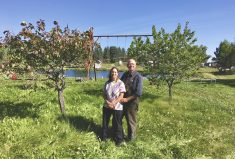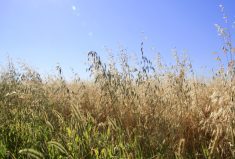Below the soil surface lurks the weed seed bank — the predominant source of weed pressure on current and future crops.
“You do not want to draw on this bank account,” said provincial crop specialist Harry Brook. “It is a source of annual and perennial weeds that will wait for years before the right conditions come about, and then germinate to steal moisture and nutrients from your crop. The seed bank consists of freshly shed seeds from this year’s weeds as well as older seeds that have persisted in the soil.”
Read Also

New crop insurer policy enables easier startup for faba beans
Agriculture Financial Services Corporation updated its normals for faba beans, which may open the door for more Canadian producers to feel comfortable growing the pulse crop in the future.
Of the many seeds in the soil seed bank, very few will ever result in adult plants.
“Most will either die, decompose, or be eaten by predators prior to germination,” said Brook. “Seed predation has the greatest effect when weed seeds are left on the soil surface, as in zero tillage or perennial forage crops. Ground beetles and crickets can reduce weed seed emergence by five to 15 per cent. Weed seeds are also consumed by rodents and birds. Keeping the soil in permanent cover increases predation on weed seeds.”
Other causes of seed mortality are lethal germination and desiccation.
“Lethal germination takes place when the seeds germinate at too great of a depth, and seeds exhaust their energy and die before emergence,” said Brook. “Kochia and some other weeds can sense the depth of burial and limit lethal germination.
“Desiccation takes place when the seeds germinate, but the soil dries out after germination starts and before emergence.”
Seeds can remain viable for hundreds of years if it stays dry and they don’t germinate. But frequent and short-term wetting and drying will increase weed seed losses due to desiccation, he said.
“This occurs more often near the soil surface. In a research trial in Montana, wild oat seed losses increased from 55 to 88 per cent as soil moisture went from six to 24 per cent.”
Seed dormancy prevents germination when conditions are otherwise conducive to germination. When weed seeds are dormant at plant maturity, it is called primary dormancy. These seeds won’t germinate until dormancy is ‘broken’ by certain conditions. But they can go into a state called secondary dormancy, and seeds can also alternate between dormancy and not dormant due to environmental conditions.
“Secondary dormancy prevents germination when the weeds cannot complete their life cycle within the time left before winter,” said Brook. “It is regulated by seasonal soil temperatures.
“For most summer annual weeds that spring germinate, the winter cold breaks dormancy, allowing spring growth. Conversely, winter annual weeds require the summer heat to break dormancy and form rosettes in the fall.”
Changes in a cropping system will also shift the prominent weeds, altering what is in the seed bank.
“Some seeds — like kochia and dandelion — will not survive more than a year or two while wild oats or redroot pigweed can last decades buried in the soil,” he said. “Perennial forages in the crop rotation deplete the soil seed bank of annual weeds — primarily weeds with a short viability in the soil. It is most effective on kochia and grassy weeds like wild oats and green foxtail.” Another strategy that effectively reduces weed seed banks is chaff collection in annual crops. “Chaff collection during harvest can prevent up to 90 per cent of weed seeds from being added to the weed seed bank.”
Position in the soil also has a marked effect on seed longevity.
“Using zero tillage places the vast majority — up to 90 per cent — of weed seeds in the top four inches, or 10 centimetres, of soil. There, they are subject to wetting and drying cycles, stimulating germination. If weed seeds are prevented from going to seed, as in a haying situation, major weed seed can be reduced.”
Cultivation places the majority of weed seeds lower than four inches into the soil, which allows them to survive longer.
Producers should use a variety of management methods to reduce the bank of weed seeds, said Brook.
“Don’t make large weed seed deposits to the soil, it is a ‘gift’ that keeps on taking.”















